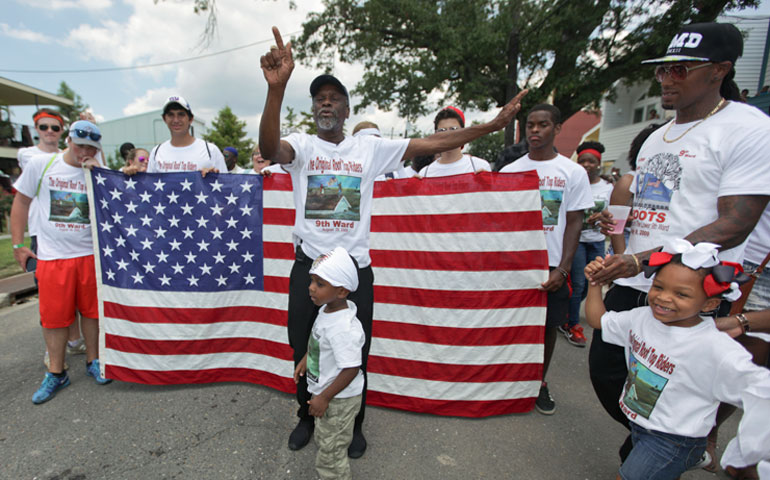
On Aug. 29, 2015, in New Orleans' Lower 9th Ward, Robert Green leads survivors of Hurricane Katrina in a second-line parade to commemorate the 10th anniversary of the storm. (Newscom/Sipa USA/Charlie Varley)
 KATRINA: AFTER THE FLOOD
KATRINA: AFTER THE FLOOD
By Gary Rivlin
Published by Simon and Schuster, $27
Released in August to coincide with the hurricane's 10th anniversary, Gary Rivlin's Katrina is an ambitious, sprawling and flawed book. It attempts to chronicle the efforts to hold businesses, neighborhoods and families together after the storm as well as the volatile debates about New Orleans' future that have marked and shaped the city's uneven and unfinished recovery. The author of five books, including the award-winning Fire on the Prairie, Rivlin reported about Hurricane Katrina for The New York Times.
Rivlin rightly believes that political ineptitude, inaction and dysfunction in the storm's aftermath engendered distrust of New Orleans' political leaders, which only attenuated and complicated the city's monumental rebuilding challenge.
Mayor Ray Nagin was, in Rivlin's correct judgment, at the center of this drama's conflicts. Elected in 2002 at age 46, Nagin, a Democrat, is an African-American and a native New Orleanian with working-class roots.
Because he had endorsed Louisiana's Democratic Gov. Kathleen Blanco's rival, Bobby Jindal, prior to Katrina, Nagin believed Blanco was punishing him for disloyalty. Rivlin, however, portrays Blanco as persistently reaching out to an uncommunicative Nagin.
His failure to work with Blanco "hampered their recovery," she said. "It meant everything took longer."
Coupled with the Bush administration's notoriously slow response to Katrina, the dysfunction was so bad that Cuba and Russia offered to help the recovery.
To win the election, Nagin appealed to New Orleans' "shadow government," that is, the whites "who controlled the business community and dominated philanthropic circles." But the mayor, who once held an 80 percent approval rating, alienated himself from these key white supporters when he told them he didn't have a recovery plan.
One supporter, Joe Canizaro, an affluent Republican real estate developer, became chairman of the mayor's Bring New Orleans Back Commission and was charged with creating a recovery blueprint in September 2005.
The question of what kind of city New Orleans would become animated the quarrels over proposed recovery recommendations. Rivlin carefully portrays Canizaro as someone who understood that "a lot of poor African-Americans had everything they own destroyed," and that, "as a white man," he couldn't dictate what happened.
The commission gave New Orleans' hardest-hit areas four months to come up with plans to demonstrate their viability. The commission also envisioned green space in once-blighted areas, but critics saw the racism of a plan that turned "black people's neighborhoods into white people's parks."
One African-American member of the commission, banker Alden McDonald, wanted to prevent any policies "that treated the hard-working poor different from others." When McDonald felt that other members of the commission hadn't heard his concerns, he developed a plan to help struggling property owners get equitable financing to rebuild.
McDonald grew up in the same 7th Ward community as Nagin had, and in 1972, became president of Liberty Bank. Situated in New Orleans East, it was the city's first minority-owned bank.
Five years after the storm, McDonald saw "just asphalt and weeds" and "giant wounds on the landscape" in New Orleans East, where upper-middle-class African-Americans had once thrived.
Nearby, in the mostly white, upper-middle-class neighborhood of Lakeview, an economic rebirth had taken place. Race, several observed, explains the disparity in these communities' efforts to rebuild. Their experiences typify New Orleans' continued unequal recovery.
Most argue New Orleans' successful charter schools demonstrate the recovery's strength. Veteran activist Barbara Major, however, asserts that these charter schools only selected the best students, leaving others behind.
Nonetheless, some believe that New Orleans' comeback has been signaled by tech company start-ups, which have attracted roughly 4,000 new persons (largely millennials) to the city each year.
But activists like Ted Quant have argued that this new entrepreneurial spirit is also tainted by injustice. "The city does look good, but for whom?" Quant asked.
As Rivlin notes, in 2013 the poverty rate in New Orleans was 29 percent -- the same rate as in 1999.
Katrina's scope is admirable, and it offers important lessons about a city's need to confront poverty and racism to better to ensure that no one is left stranded. But the book occasionally missteps.
Rivlin is an outsider and sometimes displays his lack of regional knowledge. For example, he situates the St. Thomas housing project in the Lower Garden District. Though the housing community was proximate to the venerable, stately neighborhood, no local would confuse St. Thomas with the Garden District.
Katrina's greatest flaw lies in the way Rivlin bounces from topic to topic. In one section, he asks, "Whose job was it to remove the dead after a disaster such as a Katrina?" The question intrigues, but two paragraphs later Rivlin writes about the bankruptcy of Entergy, New Orleans' public utility. And another paragraph later we read about the distraction the National Rifle Association caused after the storm.
The lack of transitions will jar and disconcert readers. Only the most determined will likely finish Katrina. Buckle up; it's a bumpy ride.
[Chris Byrd has spent more than 30 years working in nonprofits to end poverty and racism and to abolish the death penalty.]




